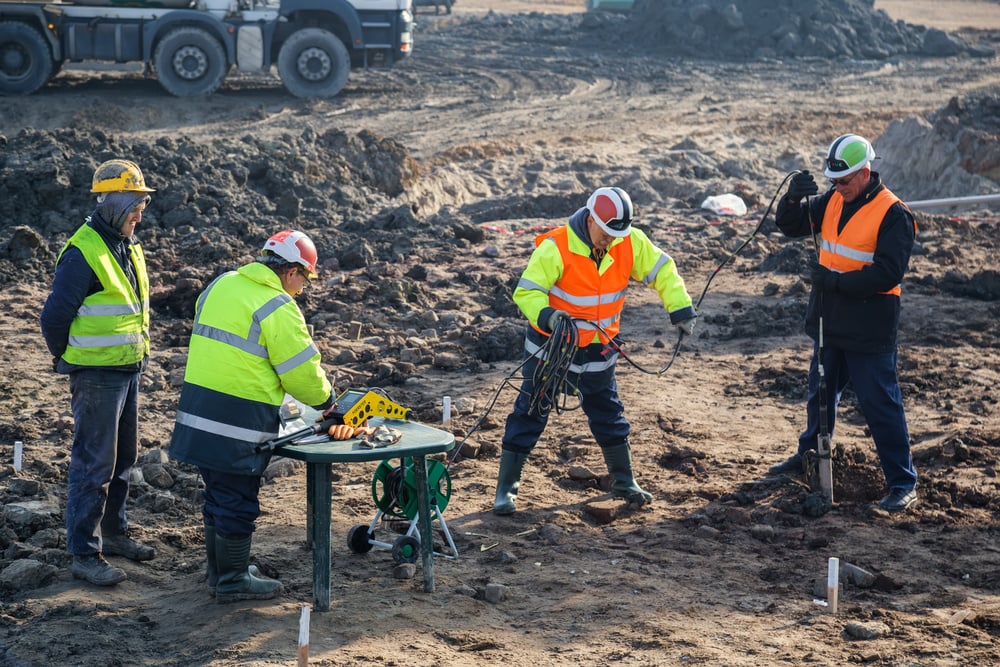The 8-Minute Rule for Geotechnical Engineering For Construction Projects
Getting My Geotechnical Engineering For Construction Projects To Work
Table of ContentsNot known Details About Geotechnical Engineering For Construction Projects See This Report on Geotechnical Engineering For Construction ProjectsThe Ultimate Guide To Geotechnical Engineering For Construction ProjectsNot known Incorrect Statements About Geotechnical Engineering For Construction Projects What Does Geotechnical Engineering For Construction Projects Do?The Best Guide To Geotechnical Engineering For Construction Projects
These features must be taken a look at by geotechnical engineers to anticipate their movements under various scenarios., making this evaluation necessary.A geotechnical designer will certainly check out dirt to identify the bearing capability of the earth and suggest correct foundation kinds, such as shallow foundations, deep foundations like stacks, or specialized options like floating structures for soft dirts. Comprehending the attributes and activities of dirt and rock, along with exactly how they engage with building and constructions that have actually been set up on or within them, is one of the key explanations for why geotechnical design is very important.
In enhancement to architectural planning and building, geotechnical design is additionally important to the restoration and upkeep of pre-existing structures. Age-related destruction or extra issues can impact a framework's security and efficiency. Environmental defense is completed with geotechnical engineering. Experience in air, water, and dirt top quality maintenance is used by geotechnical designers to lessen the negative impacts of tasks.
Framework development, offshore design, passage building and construction, and deep foundations. Risk-based style and multidisciplinary groups. These components will maintain the field advancing and ensure its continued relevance in the years to find. To sum up, geotechnical design is an essential self-control that protects the resilience and honesty of civil framework. Geotechnical designers add to making building tasks reliable around the globe by recognizing the behavior of planet products and applying suitable preparation techniques.
The Basic Principles Of Geotechnical Engineering For Construction Projects
The foundational stability of any type of project is important. Geotechnical design plays a vital role in ensuring that structures are improved strong ground, actually and figuratively. By analyzing dirt, rock, and subsurface problems, geotechnical engineers supply necessary understandings that assist in the design, building, and upkeep of buildings and infrastructure.

What Does Geotechnical Engineering For Construction Projects Mean?
Lab screening: Establishing the residential properties of soil and rock. Area testing: Carrying out tests on-site to analyze conditions. Analysis and design: Using information to make structures, maintaining wall surfaces, passages, and various other frameworks. Numerous top-level building projects have actually effectively used geotechnical engineering to ensure their stability and security. For instance:: The globe's highest structure called for a deep understanding of the underlying geology.

As Visit Your URL a leader in geotechnical engineering, BECC Inc. is committed to delivering innovative and efficient remedies that satisfy the highest possible criteria of quality and security. For more details on just how BECC Inc. can sustain your following building project, call us today and let us assist you build on strong ground.
William Rankine, a designer and physicist, created an alternative to Coulomb's earth stress theory. Albert Atterberg developed the clay consistency indices that are still made use of today for soil category. In 1885, Osborne Reynolds acknowledged that shearing causes volumetric expansion of dense materials and contraction of loose granular products. Modern geotechnical engineering is said to have begun in 1925 with the publication of Erdbaumechanik by Karl von Terzaghi, a mechanical designer and geologist.
The Basic Principles Of Geotechnical Engineering For Construction Projects
Terzaghi additionally established the framework for concepts of bearing ability of structures, and the concept for forecast of the price of negotiation of clay layers due to consolidation. After that, Maurice Biot fully developed the three-dimensional soil debt consolidation concept, expanding the one-dimensional design previously developed by Terzaghi to extra basic theories and introducing the collection of standard equations of Poroelasticity.
Geotechnical designers examine and identify the homes of subsurface problems and products. They additionally make matching earthworks and maintaining frameworks, passages, and structure structures, and might monitor and assess More Help sites, which might better include site tracking along with the danger assessment and mitigation of all-natural hazards - Geotechnical Engineering for Construction Projects. Geotechnical designers and engineering rock hounds do geotechnical investigations to get info on the physical residential or commercial properties of soil and rock hidden and beside a site to design earthworks and structures for suggested frameworks and for the repair service of distress to earthworks and frameworks triggered by subsurface problems.
Some Known Details About Geotechnical Engineering For Construction Projects
Still, they are sometimes utilized to permit a geologist or designer to be reduced right into the borehole for straight visual and hands-on exam of the dirt and rock stratigraphy. Various soil samplers exist to satisfy the requirements of different design tasks. The typical infiltration examination, which uses a thick-walled split spoon sampler, is the most typical means to accumulate disrupted examples.

Commonly, the user interface's precise geometry is unidentified, and a simplified interface geometry is assumed. Finite slopes call for three-dimensional designs to be assessed, so most inclines are assessed thinking that they are considerably broad and can be stood for by two-dimensional designs.
Unknown Facts About Geotechnical Engineering For Construction Projects
Producing the layout based on a functioning hypothesis of actions prepared for under the most likely problems. Selection of amounts to be observed as building and construction proceeds pop over to this site and computing their expected values based on the functioning theory under the most negative problems.
Measurement of amounts and examination of actual conditions. It is unsuitable for projects whose layout can not be modified during building.